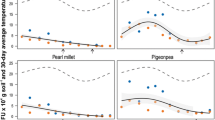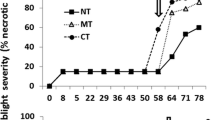Abstract
Stem rot, a destructive fungal disease caused by Sclerotinia trifoliorum Eriksson, is a serious problem for many important crops including faba beans (Vicia faba L.). Field experiments were carried out for five consecutive years in northern Greece to study the period of infection of S. Trifoliorum and the disease incidence in faba beans grown in a field that was artificially infested by placing various numbers of fungal sclerotia into the soil during the sowing period. Disease severity was very low (< 4%) in all growing seasons, whereas a high percentage of infection (13.3 to 95.0%) was observed under controlled environment. Apothecial production in the field occurred from November to early January. Symptoms of fungal infection on faba bean plants were observed from early February to early April, with the most infection occurring during March. Faba bean plants were infected by mycelium, after myceliogenic germination of sclerotia, at the base of the stem close to the soil surface. Visible, water-soaked lesions appeared before flower initiation. Disease severity was not significantly correlated with monthly rainfall (r = 0.11) nor with mean monthly temperature (r = 0.15) over five growing seasons. The growth stage of plants and the absence of an energy source during ascospore release, as well as the mode of sclerotial germination (myceliogenic), may have been the critical factors responsible for the low disease severity in the field.
Zusammenfassung
Die durch Sclerotinia trifoliorum Eriksson ausgelöste Stängel-fäule verursacht ernste Probleme in vielen bedeutenden Kulturen, unter anderem bei Ackerbohnen (Vicia faba L.). Während fünf aufeinander folgender Jahre wurden Freilandversuche in Nordgriechenland zur Untersuchung des Infektionszeitraums und der Befallshäufigkeit von S. Sclerotiorum auf künstlich während der Saat mit unterschiedlichen Sklerotienmengen infizierten Feldern durchgeführt. Die Befallshäufigkeit im Feld war in allen Versuchsjahren mit weniger als 4% vergleichsweise gering, während in Klimakammern Infektionsraten zwischen 13,3 und 95,0% beobachtet wurden. Die Apothecienbildung im Feld erfolgte zwischen November und Anfang Januar. Krankheitssymptome wurden an den Ackerbohnen zwischen Anfang Februar und Anfang April mit einem Maximum im März beobachtet. Die Ackerbohnen wurden nach der Hyphenkeimung der Sklerotien durch pilzliches Myzel an der Stängelbasis in der Nähe der Bodenoberfläche infiziert. Deutlich sichtbare Wasserflecken-Läsionen erschienen vor der Blütenbildung. Die Befallshäufigkeit war während aller fünf Vegetationsperioden nicht signifikant mit dem monatlichen Niederschlag (r = 0,11) oder der mittleren Monatstemperatur (r = 0,15) korreliert. Der Entwicklungsstand der Pflanzen und das Fehlen von Energieressourcen während der Ascosporenfreisetzung könnten in Kombination mit der Keimungsweise der Sklerotien (Hyphenkeimung) für die relativ geringe Befallsstärke im Feldbestand verantwortlich gewesen sein.
Similar content being viewed by others
Literature
Abawi, G.S., R.G. Grogan, 1975: Source of primary inoculum and effects of temperature and moisture on infection of beans by Whetzelinia sclerotiorum. Phytopathology 65, 300–309.
Bawi, G.S., F.J. Polach, W.T. Molin, 1975: Infection of bean by ascospores of Whetzelinia sclerotiorum. Phytopathology 65, 673–678.
Abawi, G.S., R.G. Grogan, 1979: Epidemiology of diseases caused by Sclerotinia species. Phytopathology 69, 899–904.
Adams, P.B., C.J. Tate, 1975: Factors affecting lettuce drop caused by Sclerotinia sclerotiorum. Plant Dis. Reptr. 59, 140–143.
Adams, P.B., C.J. Tate, 1976: Mycelial germination of sclerotia of Sclerotinia sclerotiorum on soil. Plant Dis. Reptr. 60, 515–518.
Adams, P.B., W.A. Ayers, 1979: Ecology of Sclerotinia species. Phytopathology 69, 896–899.
Dijkstra, J., 1964: Inoculation with ascospores of Sclerotinia trifoliorum for detection of clover rot resistant red clover. Euphytica 23, 314–329.
Dijkstra, J., 1966: Rotting by spread of mycelium from ascospore lesions of Sclerotinia trifoliorum. Neth. J. Plant Pathol. 72, 279–283.
Halimi, E.S., D.E. Rowe, 1998: Stem-tip inoculation of alfalfa with Sclerotinia trifoliorum: I. Development of necrosis on resistant and susceptible selections. Crop Sci. 38, 20–22.
Huang, H.C., J. Dueck, 1980: Wilt of sunflower from infection by mycelial-germinati ng sclerotia of Sclerotinia scle rotiorum. Can. J. Plant Pathol. 2, 47–52.
Kreitlow, K.W., V.G. Spraque, 1951: Effect of temperature on growth and pathogenicity of Sclerotinia trifoliorum. Phytopathology 41, 752–757.
Le Tourneau, D., 1979: Morphology, cytology, and physiology of Sclerotinia species in culture. Phytopathology 69, 887–890.
Lithourgidis, A.S., 1991: Faba beans (Vicia faba L.) resistance against species of the genus Sclerotinia. Ph.D. thesis, Aristotle University of Thessaloniki, Greece.
Lithourgidis, A.S., 2004: Infection of faba beans by Sclerotinia trifoliorum. Can. J. Plant Sci. 84, 1235–1237.
Lithourgidis, A.S., K. Tzavella-Klonari, D.G. Roupakias, 1989: Methods of inoculation of faba bean plants with Sclerotinia sclerotiorum. J. Phytopathol. 127, 123–128.
Lithourgidis, A.S., D.G. Roupakias, K. Tzavella-Klonari, 1991: Factors affecting the differentiation of resistant faba bean plants after inoculation with Sclerotinia trifoliorum. Plant Breed. 107, 258–261.
Lithourgidis, A.S., K. Tzavella-Klonari, D.G. Roupakias, 2003: The causal fungus of stem rot disease of faba beans in Greece. J. Phytopathol. 151, 631–635.
Lithourgidis, A.S., D.G. Roupakias, C.A. Damalas, 2004: Evaluation of faba beans for resistance to sclerotinia stem rot caused by Sclerotinia trifoliorum. Phytoprotection 85, 89–94.
Loveless, A.R., 1951: Observations on the biology of clover rot. Ann. Appl. Biol. 38, 642–664.
Lumsden, R.D., 1979: Histology and physiology of pathogenesis in plant diseases caused by Sclerotinia species. Phytopathology 69, 890–896.
Mcquilken, M.P., S.J. Mitchell, S.A. Archer, 1994: Origin of early attacks of Sclerotinia stem rot on winter oilseed rape in the UK. J. Phytopathol. 140, 179–186.
Newton, H.C., L. Sequeira, 1972: Ascospores as the primary infective propagule of Sclerotinia sclerotiorum in Wisconsin. Plant Dis. Reptr. 56, 798–802.
Podimatas, K.I., A.J. Karamanos, 1991: Present status and future prospects of faba bean production and improvement in Greece. Options Méditerran. 10, 139–142.
Pratt, R.G., 1992: Morphology and host specialization of Sclerotinia trifoliorum from small hop clover. Plant Dis. 76, 661–664.
Pratt, R.G., W.E. Knight, 1982: Formation of apothecia by sclerotia of Sclerotinia trifoliorum and infection of crimson clover in the field. Plant Dis. 66, 1021–1023.
Purdy, L.H., 1979: Sclerotinia sclerotiorum: History, diseases and symptom-matology, host range, geographic distribution, and impact. Phytopathology 69, 875–880.
Raynal, G., 1987: Facteurs agissant sur la formation des apothécies de Sclerotinia trifoliorum Eriks. en conditions contrôlées. Agronomie 7, 715–725.
Schmidt, D., 1980: Etudes sur la résistance du tréfle violet à Sclerotinia trifoliorum Eriks. Rev. Suisse Agric. 12, 197–206.
Schmidt, D., 1981: Le tréfle violet-sa longévite et ses ennemis. Rev. Suisse Agric. 13, 149–158.
Scott, S.W., A.H. Fielding, 1985: Differences in pectolytic enzyme patterns induced in Sclerotinia trifoliorum by different legume host species. Trans Br. Mycol. Soc. 84, 317–324.
Steadman, J.R., 1983: White mold–A serious yield-limiting disease of bean. Plant Dis. 67, 346–350.
Suzui, T., T. Kobayashi, 1972: Dispersal of ascospores of Sclerotinia sclerotiorum (Lib.) de Bary on kidney bean plants. Hokkaido Nat. Agric. Exp. Stn. Res. Bull. 102, 61–68.
Theohari-Athanasiou, I., 1990: Observations on infections by Sclerotinia species in autumn legumes, In: Ministry of Agriculture of Greece (eds.): Proceedings of National Agricultural Research Symposium, Vol. 1, p. 111. Athens, Greece.
Williams, G.H., J.H. Western, 1965: The biology of Sclerotinia trifoliorum Eriks. and other species of sclerotium-forming fungi. I. Apothecium formation from sclerotia. Ann. Appl. Biol. 56, 253–260.
Author information
Authors and Affiliations
Corresponding author
Rights and permissions
About this article
Cite this article
Lithourgidis, A.S., Roupakias, D.G. & Tzavella-Klonari, K. Stem rot disease incidence on faba beans in an artificially infested field. J Plant Dis Prot 114, 120–125 (2007). https://doi.org/10.1007/BF03356719
Received:
Accepted:
Published:
Issue Date:
DOI: https://doi.org/10.1007/BF03356719




